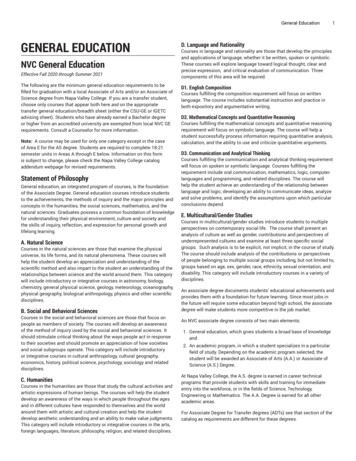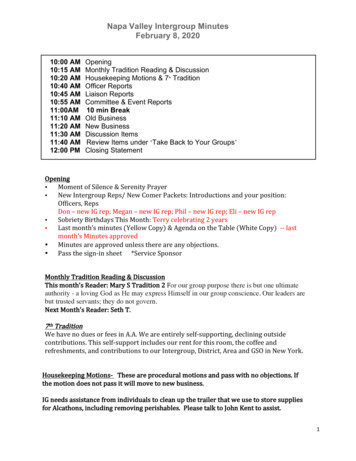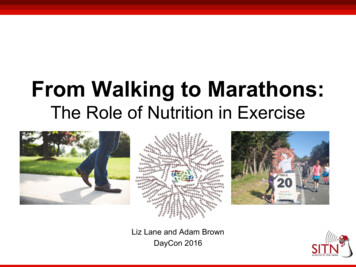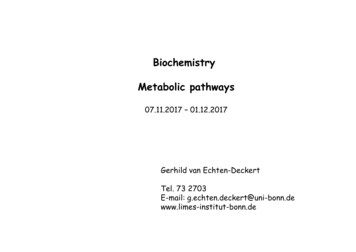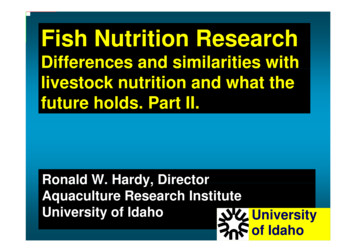
Transcription
Chapter17Nutrition andMetabolismPowerPoint Lecture Slidesprepared by Jason LaPresLone Star College - North HarrisCopyright 2010 Pearson Education, Inc.Copyright 2010 Pearson Education, Inc.
Introduction to Nutrition andMetabolism Cells break down organic molecules toobtain energy– Used to generate ATP Most energy production takes place inmitochondriaCopyright 2010 Pearson Education, Inc.
Metabolism Body chemicals– Oxygen– Water– Nutrients: Vitamins Mineral ions Organic substratesCopyright 2010 Pearson Education, Inc.
Metabolism Body chemicals– Cardiovascular system: Carries materials through body– Materials diffuse: From bloodstream into cellsCopyright 2010 Pearson Education, Inc.
17-1 Metabolism refers to allthe chemical reactions that occurin the bodyCopyright 2010 Pearson Education, Inc.
Metabolism Metabolism refers to all chemical reactions inan organism Cellular Metabolism– Includes all chemical reactions within cells– Provides energy to maintain homeostasis andperform essential functionsCopyright 2010 Pearson Education, Inc.
Metabolism Essential Functions– Metabolic turnover: Periodic replacement of cell’s organic components– Growth and cell division– Special processes, such as secretion, contraction,and the propagation of action potentialsCopyright 2010 Pearson Education, Inc.
Cellular MetabolismFigure 17-1Copyright 2010 Pearson Education, Inc.
Metabolism The Nutrient Pool– Contains all organic building blocks the cellneeds: To provide energy To create new cellular components– Is source of substrates for catabolism andanabolismCopyright 2010 Pearson Education, Inc.
Metabolism Catabolism– Is the breakdown of organic substrates– Releases energy used to synthesize high-energycompounds (e.g., ATP) Anabolism– Is the synthesis of new organic moleculesCopyright 2010 Pearson Education, Inc.
Metabolism In energy terms– Anabolism is an “uphill” process that formsnew chemical bondsCopyright 2010 Pearson Education, Inc.
Metabolism Functions of Organic Compounds– Perform structural maintenance and repairs– Support growth– Produce secretions– Store nutrient reservesCopyright 2010 Pearson Education, Inc.
Metabolism Organic Compounds– Glycogen: Most abundant storage carbohydrate A branched chain of glucose molecules– Triglycerides: Most abundant storage lipids Primarily of fatty acids– Proteins: Most abundant organic components in body Perform many vital cellular functionsCopyright 2010 Pearson Education, Inc.
Nutrient Use in Cellular MetabolismFigure 17-2Copyright 2010 Pearson Education, Inc.
17-2 Carbohydrate metabolisminvolves glycolysis, ATPproduction, and gluconeogenesisCopyright 2010 Pearson Education, Inc.
Carbohydrate Metabolism Generates ATP and other high-energycompounds by breaking downcarbohydrates:glucose oxygenCopyright 2010 Pearson Education, Inc.carbon dioxide water
Glycolysis Glucose Breakdown– Occurs in small steps: Which release energy to convert ADP to ATP– One molecule of glucose nets 36 molecules of ATP– Glycolysis: Breaks down glucose in cytosol into smaller molecules usedby mitochondria Does not require oxygen: anaerobic reaction– Aerobic Reactions: Also called aerobic metabolism or cellular respiration Occur in mitochondria, consume oxygen, and produce ATPCopyright 2010 Pearson Education, Inc.
Glycolysis Glycolysis– Breaks 6-carbon glucose– Into two 3-carbon pyruvic acid Pyruvate– Ionized form of pyruvic acidCopyright 2010 Pearson Education, Inc.
Glycolysis Glycolysis Factors– Glucose molecules– Cytoplasmic enzymes– ATP and ADP– Inorganic phosphates– NAD (coenzyme)Copyright 2010 Pearson Education, Inc.
Figure17-3Copyright 2010 Pearson Education, Inc.
Energy Production Within Mitochondria If oxygen supplies are adequate, mitochondriaabsorb and break down pyruvic acid molecules:– H atoms of pyruvic acid are removed by coenzymesand are a primary source of energy gain– C and O atoms are removed and released as CO2 inthe process of decarboxylationCopyright 2010 Pearson Education, Inc.
Energy Production Within Mitochondria The TCA Cycle (citric acid cycle)– The function of the citric acid cycle is: To remove hydrogen atoms from organic molecules andtransfer them to coenzymes– In the mitochondrion: Pyruvic acid reacts with NAD and coenzyme A (CoA) Producing 1 CO2, 1 NADH, 1 acetyl-CoA– Acetyl group transfers: From acetyl-CoA to oxaloacetic acid Produces citric acidCopyright 2010 Pearson Education, Inc.
Energy Production Within Mitochondria The TCA Cycle– CoA is released to bind another acetyl group– One TCA cycle removes two carbon atoms: Regenerating 4-carbon chain––––Several steps involve more than one reaction or enzymeH2O molecules are tied up in two stepsCO2 is a waste productThe product of one TCA cycle is: One molecule of ATPThe TCA CycleCopyright 2010 Pearson Education, Inc.
Energy Production Within Mitochondria Summary: The TCA CycleCH3CO CoA 3NAD FAD GDP Pi 2 H2OCoA 2 CO2 3NADH FADH2 2 H ATPCopyright 2010 Pearson Education, Inc.
The TCA CycleFigure 17-4Copyright 2010 Pearson Education, Inc.
Energy Production Within Mitochondria Oxidative Phosphorylation and the ETS– Is the generation of ATP: Within mitochondria In a reaction requiring coenzymes and oxygen– Produces more than 90% of ATP used bybody– Results in 2 H2 O2Copyright 2010 Pearson Education, Inc.2 H2O
Energy Production Within Mitochondria The Electron Transport System (ETS)– Is the key reaction in oxidativephosphorylation– Is in inner mitochondrial membrane– Electrons carry chemical energy: Within a series of integral and peripheral proteinsCopyright 2010 Pearson Education, Inc.
Energy Production Within Mitochondria The Electron Transport System (ETS)– Also called respiratory chain– Is a sequence of proteins (cytochromes): Protein:– embedded in inner membrane of mitochondrion– surrounds pigment complex Pigment complex:– contains a metal ion (iron or copper)Copyright 2010 Pearson Education, Inc.
Figure 17-5Copyright 2010 Pearson Education, Inc.
Energy Yield of Glycolysis and CellularRespiration For most cells, reaction pathway– Begins with glucose– Ends with carbon dioxide and water– Is main method of generating ATPCopyright 2010 Pearson Education, Inc.
Energy Yield of Glycolysis and CellularRespiration Summary: ATP Production– For one glucose molecule processed, cell gains 36molecules of ATP: 2 from glycolysis4 from NADH generated in glycolysis2 from TCA cycle (through GTP)28 from ETSCopyright 2010 Pearson Education, Inc.
Alternative Catabolic PathwaysFigure 17-6Copyright 2010 Pearson Education, Inc.
Gluconeogenesis Is the synthesis of glucose fromnoncarbohydrate precursors– Lactic acid– Glycerol– Amino acids Stores glucose as glycogen in liver and skeletalmuscleCopyright 2010 Pearson Education, Inc.
Carbohydrate MetabolismFigure 17-7Copyright 2010 Pearson Education, Inc.
17-3 Lipid metabolism involveslipolysis, beta-oxidation, and thetransport and distribution of lipidsas lipoproteins and free fattyacidsCopyright 2010 Pearson Education, Inc.
Lipid Metabolism Lipid molecules contain carbon, hydrogen,and oxygen– In different proportions than carbohydrates Triglycerides are the most abundant lipidin the bodyCopyright 2010 Pearson Education, Inc.
Lipid Metabolism Lipid Catabolism (also called lipolysis)– Breaks lipids down into pieces that can be: Converted to pyruvic acid Channeled directly into TCA cycle– Hydrolysis splits triglyceride into component parts: One molecule of glycerol Three fatty acid moleculesCopyright 2010 Pearson Education, Inc.
Lipid Metabolism Lipid Catabolism– Enzymes in cytosol convert glycerol to pyruvicacid: Pyruvic acid enters TCA cycle– Different enzymes convert fatty acids toacetyl-CoA (beta-oxidation)Copyright 2010 Pearson Education, Inc.
Lipid Metabolism Beta-Oxidation––––A series of reactionsBreaks fatty acid molecules into 2-carbon fragmentsOccurs inside mitochondriaEach step: Generates molecules of acetyl-CoA and NADH Leaves a shorter carbon chain bound to coenzyme ACopyright 2010 Pearson Education, Inc.
Lipids and Energy Production For each 2-carbon fragment removed from fattyacid, cell gains– 2 ATP from acetyl-CoA in TCA cycle– 5 ATP from NADH Cell can gain 144 ATP molecules frombreakdown of one 18-carbon fatty acid molecule Fatty acid breakdown yields about 1.5 times theenergy of glucose breakdownCopyright 2010 Pearson Education, Inc.
Lipid Synthesis Can use almost any organic substrate– Because lipids, amino acids, and carbohydrates canbe converted to acetyl-CoA Glycerol– Is synthesized from dihydroxyacetone phosphate(intermediate product of glycolysis) Other Lipids– Nonessential fatty acids and steroids are examples– Are synthesized from acetyl-CoACopyright 2010 Pearson Education, Inc.
Lipid Transport and Distribution Cells require lipids– To maintain plasma membranes Steroid hormones must reach target cellsin many different tissuesCopyright 2010 Pearson Education, Inc.
Lipid Transport and Distribution Lipoproteins– Are lipid–protein complexes– Contain large insoluble glycerides and cholesterol– Five classes of lipoproteins: Chylomicrons Very low-density lipoproteins (VLDLs) Intermediate-density lipoproteins (IDLs) Low-density lipoproteins (LDLs) High-density lipoproteins (HDLs)Copyright 2010 Pearson Education, Inc.
Lipid SynthesisFigure 17-8Copyright 2010 Pearson Education, Inc.
17-4 Protein catabolism involvestransamination and deamination,whereas protein synthesisinvolves amination andtransaminationCopyright 2010 Pearson Education, Inc.
Protein Metabolism The body synthesizes 100,000 to 140,000proteins– Each with different form, function, and structure All proteins are built from the 20 amino acids Cellular proteins are recycled in cytosol– Peptide bonds are broken– Free amino acids are used in new proteinsCopyright 2010 Pearson Education, Inc.
Protein Metabolism If other energy sources are inadequate– Mitochondria generate ATP by breaking downamino acids in TCA cycle Not all amino acids enter cycle at samepoint, so ATP benefits varyCopyright 2010 Pearson Education, Inc.
Amino Acid Catabolism Removal of amino group bytransamination or deamination– Requires coenzyme derivative of vitamin B6(pyridoxine)Copyright 2010 Pearson Education, Inc.
Protein Metabolism Transamination– Attaches amino group of amino acid: To keto acid– Converts keto acid into amino acid: That leaves mitochondrion and enters cytosol Available for protein synthesisCopyright 2010 Pearson Education, Inc.
Protein Metabolism Deamination– Prepares amino acid for breakdown in TCAcycle– Removes amino group and hydrogen atom: Reaction generates ammonium ionCopyright 2010 Pearson Education, Inc.
Protein Metabolism Proteins and ATP Production– When glucose and lipid reserves areinadequate, liver cells: Break down internal proteins Absorb additional amino acids from blood– Amino acids are deaminated: Carbon chains broken down to provide ATPCopyright 2010 Pearson Education, Inc.
Protein Metabolism Three Factors Against Protein Catabolism– Proteins are more difficult to break apart thancomplex carbohydrates or lipids– A by-product, ammonium ion, is toxic to cells– Proteins form the most important structuraland functional components of cellsCopyright 2010 Pearson Education, Inc.
Amino Acids and Protein Synthesis Protein Synthesis– The body synthesizes half of the amino acidsneeded to build proteins– Nonessential amino acids: Amino acids made by the body on demandCopyright 2010 Pearson Education, Inc.
Amino Acids and Protein Synthesis Protein Synthesis– Ten essential amino acids: Eight not synthesized:– isoleucine, leucine, lysine, threonine, tryptophan,phenylalanine, valine, and methionine Two insufficiently synthesized:– arginine and histidineCopyright 2010 Pearson Education, Inc.
Figure 17-9Copyright 2010 Pearson Education, Inc.
17-5 Nucleic acid catabolisminvolves RNA, but not DNACopyright 2010 Pearson Education, Inc.
RNA Catabolism Disassemble to nucleotides Sugar (ribose) and cytosine and uracil canbe catabolized and enter TCA Adenine and guanine are not catabolized– Deaminized to uric acid for excretion: goutCopyright 2010 Pearson Education, Inc.
Nucleic Acid Synthesis DNA via replication– Prior to cell division RNA via transcription– Beginning of protein synthesisCopyright 2010 Pearson Education, Inc.
17-6 Adequate nutrition isnecessary to prevent deficiencydisorders and maintainhomeostasisCopyright 2010 Pearson Education, Inc.
Nutrition Homeostasis can be maintained only if digestivetract absorbs enough fluids, organic substrates,minerals, and vitamins to meet cellular demands Nutrition is the absorption of nutrients from food The body’s requirement for each nutrient variesCopyright 2010 Pearson Education, Inc.
Nutrition Food Groups and MyPyramid Plan– A balanced diet contains all components needed tomaintain homeostasis: Substrates for energy generation Essential amino acids and fatty acids Minerals and vitamins– Must also include water to replace urine, feces,evaporationCopyright 2010 Pearson Education, Inc.
Copyright 2010 Pearson Education, Inc.
The MyPyramid PlanFigure 17-10Copyright 2010 Pearson Education, Inc.
Minerals, Vitamins, and Water Are essential components of the diet– The body does not synthesize minerals– Cells synthesize only small quantities of a fewvitamins: Ions such as sodium and chloride determine theosmotic concentration of body fluids. Ions in various combinations play major roles inimportant physiological processes. Ions are essential cofactors in a variety ofenzymatic reactions.Copyright 2010 Pearson Education, Inc.
NutritionCopyright 2010 Pearson Education, Inc.
NutritionCopyright 2010 Pearson Education, Inc.
Nutrition Fat-Soluble Vitamins– Vitamins A, D, E, and K: Are absorbed primarily from the digestive tractalong with lipids of micelles Normally diffuse into plasma membranes and lipidsin liver and adipose tissueCopyright 2010 Pearson Education, Inc.
Nutrition Vitamin A– A structural component of visual pigment retinal Vitamin D– Is converted to calcitriol, which increases rate ofintestinal calcium and phosphorus absorption Vitamin E– Stabilizes intracellular membranes Vitamin K– Helps synthesize several proteins, including threeclotting factorsCopyright 2010 Pearson Education, Inc.
Copyright 2010 Pearson Education, Inc.
Nutrition Water-Soluble Vitamins– Are components of coenzymes– Are rapidly exchanged between fluid indigestive tract and circulating blood: Excesses are excreted in urineCopyright 2010 Pearson Education, Inc.
NutritionCopyright 2010 Pearson Education, Inc.
NutritionCopyright 2010 Pearson Education, Inc.
Nutrition Water– Need about 2500 mL/day– Requirements based on other metabolicfactorsCopyright 2010 Pearson Education, Inc.
Diet and Disease Average U.S. diet contains excessive amountsof sodium, calories, and lipids Poor diet contributes to– Obesity– Heart disease– Atherosclerosis– Hypertension– DiabetesCopyright 2010 Pearson Education, Inc.
17-7 Metabolic rate is theaverage caloric expenditure,and thermoregulation involvesbalancing heat-producingand heat-losing mechanismsCopyright 2010 Pearson Education, Inc.
Metabolic Rate Energy Gains and Losses– Energy is released: When chemical bonds are broken– In cells: Energy is used to synthesize ATP Some energy is lost as heatCopyright 2010 Pearson Education, Inc.
Units of Energy Calories– Energy required to raise 1 g of water 1 degreeCelsius is a calorie (cal)– Energy required to raise 1 kilogram of water 1 degreeCelsius is a Calorie (Cal) kilocalorie (kcal) The Energy Content of Food– Lipids release 9.46 Cal/g– Carbohydrates release 4.18 Cal/g– Proteins release 4.32 Cal/gCopyright 2010 Pearson Education, Inc.
Energy Expenditure: Metabolic Rate Clinicians examine metabolism todetermine calories used and measured in– Calories per hour– Calories per day– Calories per unit of body weight per day Metabolic rate is the sum of all anabolicand catabolic processes in the body Metabolic rate changes according toactivityCopyright 2010 Pearson Education, Inc.
Energy Expenditure: Metabolic Rate Basal Metabolic Rate (BMR)– Is the minimum resting energy expenditure: Of an awake and alert person Measured under standardized testing conditions– Measuring BMR: Involves monitoring respiratory activity Energy utilization is proportional to oxygenconsumptionCopyright 2010 Pearson Education, Inc.
Energy Expenditure: Metabolic Rate Metabolic Rate– If daily energy intake exceeds energy demands: Body stores excess energy as triglycerides in adipose tissue– If daily caloric expenditures exceed dietary supply: Body uses energy reserves, loses weightCopyright 2010 Pearson Education, Inc.
Thermoregulation Heat production– BMR estimates rate of energy use– Energy not captured is released as heat: serves important homeostatic purposeCopyright 2010 Pearson Education, Inc.
Thermoregulation Body Temperature– Enzymes operate in a limited temperaturerange– Homeostatic mechanisms keep bodytemperature within limited range(thermoregulation)Copyright 2010 Pearson Education, Inc.
Thermoregulation Mechanisms of Heat Transfer– Heat exchange with environment involves fourprocesses: RadiationConductionConvectionEvaporationCopyright 2010 Pearson Education, Inc.
Thermoregulation Radiation– Warm objects lose heat energy as infrared radiation: Depending on body and skin temperature– About 50% of indoor heat is lost by radiation Conduction– Is direct transfer of energy through physical contact– Is generally not effective in heat gain or lossCopyright 2010 Pearson Education, Inc.
Thermoregulation Convection– Results from conductive heat loss to air at body surfaces– As body conducts heat to air, that air warms and rises and isreplaced by cooler air– Accounts for about 15% of indoor heat loss Evaporation– Absorbs energy (0.58 Cal per gram of water evaporated)– Cools surface where evaporation occurs– Evaporation rates at skin are highly variableCopyright 2010 Pearson Education, Inc.
Thermoregulation Insensible Water Loss– Each hour, 20–25 mL of water crosses epithelia and evaporatesfrom alveolar surfaces and skin surface– Accounts for about 20% of indoor heat loss Sensible Perspiration– From sweat glands– Depends on wide range of activity: From inactivity to secretory rates of 2–4 liters (2.1–4.2 quarts) perhourCopyright 2010 Pearson Education, Inc.
Thermoregulation The Regulation of Heat Gain and HeatLoss– Is coordinated by heat-gain center and heatloss center in preoptic area of anteriorhypothalamus: Modify activities of other hypothalamic nucleiCopyright 2010 Pearson Education, Inc.
Thermoregulation Temperature Control– Is achieved by regulating: Rate of heat production Rate of heat loss to environment– Further supported by behavioral modificationsCopyright 2010 Pearson Education, Inc.
Thermoregulation Mechanisms for Increasing Heat Loss– When temperature at preoptic nucleusexceeds set point: The heat-loss center is stimulatedCopyright 2010 Pearson Education, Inc.
Thermoregulation Three Actions of Heat-Loss Center– Inhibition of vasomotor center: Causes peripheral vasodilation Warm blood flows to surface of body and skin temperature rises Radiational and convective losses increase– Sweat glands are stimulated to increase secretory output: Perspiration flows across body surface Evaporative heat losses increase– Respiratory centers are stimulated: Depth of respiration increasesCopyright 2010 Pearson Education, Inc.
Thermoregulation Mechanisms for Promoting Heat Gain– The heat-gain center prevents low bodytemperature (hypothermia)– When temperature at preoptic nucleus drops: Heat-loss center is inhibited Heat-gain center is activatedCopyright 2010 Pearson Education, Inc.
Thermoregulation Heat Conservation– Sympathetic vasomotor center decreases blood flowto dermis: Reducing losses by radiation, convection, and conduction– In cold conditions: Blood flow to skin is restricted Blood returning from limbs is shunted to deep, insulatedveins (countercurrent exchange)Copyright 2010 Pearson Education, Inc.
Thermoregulation Heat Dissipation– In warm conditions: Blood flows to superficial venous network Heat is conducted outward to cooler surfacesCopyright 2010 Pearson Education, Inc.
ThermoregulationFigure 17-11Copyright 2010 Pearson Education, Inc.
Thermoregulation Two mechanisms for generating heat– Shivering thermogenesis: Increased muscle tone increases energy consumption ofskeletal muscle, which produces heat Involves agonists and antagonists, and degree of stimulationvaries with demand Shivering increases heat generation up to 400%– Nonshivering thermogenesis: Releases hormones that increase metabolic activity Raises heat production in adults 10% to 15% over extendedtime periodCopyright 2010 Pearson Education, Inc.
17-8 Caloric needs decline withadvancing ageCopyright 2010 Pearson Education, Inc.
Nutrition and Aging For each decade after age 50, caloricrequirements decrease by 10%.– Reductions in metabolic rates, body mass,activity levels, and exercise tolerance Increased need of calciumCopyright 2010 Pearson Education, Inc.
Food Groups and MyPyramid Plan –A balanced diet contains all components needed to maintain homeostasis: Substrates for energy generation Essential amino acids and fatty acids Minerals and vitamins –Mus



